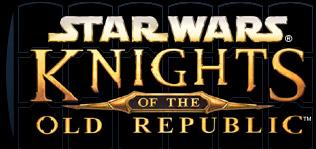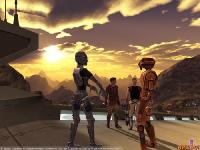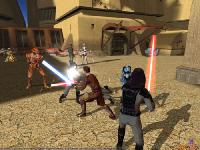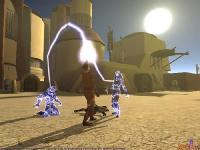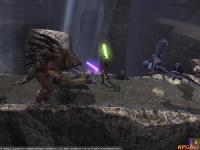|
|
|
Main News Forums Games Games Database Top 100 Release List Support Files Features Reviews Previews Interviews Editorials Diaries Misc Download Gallery Music Screenshots Videos Miscellaneous Staff Members Privacy Statement |
SW: Knights of the Old Republic (XBox) Review
Star Wars games are a mixed bag. I'm betting most fans, and gamers in general, would agree with me on that. As the recent Star Wars films and past LucasArts releases have proved, ruling over all decisions with an iron fist will certainly guarantee that you know how things will turn out, but not that the finished product will be worth anything. Which is why enlisting RPG veterans Bioware to handle the actual design and development of the first Star Wars role-playing game has to be the best decision made by LucasArts in the last… well, probably ever. In the past, with every release of a new Star Wars game, the faithful have lined up hopefully, trusting that this time, at least, the results would live up to the game in their imagination, and take them to live in a galaxy far away, at least for a while. Star Wars: Knights of the Old Republic may be the game to finally do just that.
Role-Playing in a galaxy far, far away Professional sheen and flawless production values are the trademarks of a Bioware game, and Knights is no exception. The actual gameplay closely resembles their Neverwinter Nights or Baldurs Gate, but the presentation and execution is markedly different. Character creation is relatively simple, with three main character choices possible - soldier, scout, and scoundrel - essentially the warrior, ranger, and thief of any RPG. However, you will also have the opportunity to choose a separate Jedi class a short while into the game. Attribute points are spent on main abilities like strength and dexterity, and skills like computer use, security, and healing are available to put points into. In addition, feats may be chosen to further specialize your character. If all this sounds a bit familiar, it may be because the game engine is based on an adapted D&D third edition ruleset. However, the conversion is seamless, and works surprisingly well within the structure of the Star Wars universe. Another aspect of the game where the D&D lineage becomes evident is during battle. Though the game is viewed from a third person perspective similar to a Tomb Raider type adventure game, all combat takes place in a real-time, turn-based system - you can pause the game at will, or set auto-pause options to stop the game automatically between rounds and other events. You issue commands to fight, heal, or use force powers, but your success at performing these actions is based on dice rolls performed by the computer dependent on your skills and/or weapons, and not your personal speed or hand-eye coordination. It's basically the same system featured in Neverwinter Nights, but it's infinitely more interesting to watch here. When fighting in a melee situation, swords clash, lightsabers block and parry, characters spin, jump, and kick, and every move looks fantastic. You'll find yourself looking forward to getting in fights just so you can watch the carnage up close.
Controlling a Jedi The enjoyment of the combat, and indeed, the rest of the game, is enhanced by the brilliantly designed interface and control setup. RPG's generally fare much better on a PC platform, where the mouse and keyboard setup provide an optimal interface with the game, and although I'm sure the PC version of Knights will be no exception to this rule, the Xbox controller and hardware are used to their fullest capabilities in making the game a joy to navigate. The left analog stick controls movement, while the right stick moves the camera. When enemies are sighted the game pauses (if you choose), and the triggers scroll back and forth across possible targets. The A button engages combat mode to begin a fight, and the directional pad is used to scroll through possible actions. Actions can be stacked to be performed in order, or you can just let your characters battle it out in easy fights, as attack is the default command. Pressing start takes you into the menu screens, where you can easily outfit your characters, consult your journal, review your quests, examine your characters abilities, or save your game. The triggers scroll through the menus, and the whole thing is a breeze to learn and use. The main plot of Knights is quite well done, features a few twists that you might not see coming, and all in all, it's several steps above the plots in the recent films. The story is helped in large part by the fact that all dialogue in the game is spoken, and is well performed and recorded, to boot. Bioware has done an amazing job assembling voice talent to make this game come alive, and for once, I found myself actually listening to most of the conversations, instead of just reading and skipping ahead. Characters react according to your responses, and the whole thing feels a lot like a movie that you're largely in control of. One of the main attractions of this game comes from the fact that during nearly every main or side quest, you have real choices that have an impact on the game. You're constantly asked to make difficult choices and decisions during conversations, and your path through the game, and to the light or dark side, is affected by all of them. And as you choose your path, you'll discover secrets, explore the galaxy, and become a Jedi - giving you access to the Force.
Use the Force (Luke) Force powers are similar to the magic spells of a high-fantasy RPG, and though any Jedi can choose any of the Force powers available, your alignment toward the light or dark side of the Force determines how many Force points (think mana) those powers cost to use. So if you're a goody two-shoes trying to put a nasty chokehold on an enemy, it's going to cost you. However, your Force alignment is a dynamic, constantly changing factor in the game, as nearly every important decision you make has an effect on your standing. A weakness of many supposedly open-ended RPG's is the amount of effort that needs to be expended to play the game as an evil character. When traveling the black path, so to speak, your character is usually despised; shopkeepers run up prices or just won't sell to you, and guards and other authority figures often attack on sight. In Knights, while playing to the dark side has its challenges, it is a viable gameplay option, and one that will have many fans of the game restarting and replaying at least a second time through. Your companions also add a lot of replay value. You'll amass a crew of nine separate characters that will decide to throw in their lot with you, for various reasons - among them a Wookie, a Twi'lek, three Jedi… and best of all, a homicidal droid assassin, HK-47, that you'll take with you everywhere just for the intrinsic entertainment value. You can travel with any two of them at a time, and their interactions and motivations will provide extra story details, and occasionally, additional quest opportunities. They can be equipped with anything you have in your inventory, and you can either control them directly during combat (or any other time), or allow them to perform their default actions, which are generally pretty situation appropriate. Their default actions can also be altered via the character menu. They'll level up when you level up, and you can either delve into their character development or let the computer auto-level them for you. It's a well-implemented party system, and one that lets you have companions without needing to think about them too much - also made possible by the excellent path-finding.
I hear Kashyyyk is beautiful in the summertime The graphics and sound are, for the most part, fantastic. The environments are detailed and interesting, and although there is no night/day cycle, each planet you'll visit has a distinctive look and feel appropriate to the setting. Tatooine is dusty, dry, and hot (one would assume), Kashyyyk (the Wookie home world) is a verdant and dangerous world viewed mostly from among the tops of the trees, Manaan is a planet entirely covered by water, with a gorgeous floating city to explore - and that only covers half of the locations you'll visit during the course of the game. The score sounds like nearly every other Star Wars score, but it's non-intrusive and used to good effect. The ambient noise and sound effects do a good of job of drawing you into the Star Wars universe, and the classic sounds, like blasters and light sabers, are dead on. The character models look great, and the fighting animations, as previously mentioned, are one of the high points of the game. If there's one complaint to make about the graphics, it's that several of the facial models are used multiple times, and the facial control could be a bit better. But these are minor complaints, and you'll likely find little fault with the superb graphics. However, you will get tired of loading times. Game areas aren't, as a rule, very large, and moving from one area to another, or entering most interiors, will require loading. The load times themselves aren't that long, but the frequency with which they occur can be a bit annoying. Keeping busy in space One of the game's main strengths is in the variety, quantity, and freedom found in its quests. From world to world, possible diversions crop up everywhere, with some requiring frequent interstellar travel. The main quest keeps you moving, but you can also arbitrate in trials, investigate crimes and other mysteries, assassinate criminals, participate in political plots, and of course, fetch various items for various characters - though this RPG quest mainstay is used infrequently and to good effect. There are also three minigames of varying quality and entertainment. A shooting segment where you blast pursuing ships is the least entertaining, mainly because there is no real tension or threat in the battles - the ships fire on you repeatedly, doing no damage, until you blast them all, and a cut scene sweeps you away. A blackjack-like card game called Pazaak is a pleasant and strategic diversion, and can also prove a good source of money once you get good at it. Swoop racing is probably the most entertaining of the minigames, as it takes a healthy amount of practice and track awareness to really excel at it, but once you get the hang of it, it's quite deep and challenging.
It really is that good The overall experience of playing Knights is almost overwhelming, because the game is perfectly executed in nearly every respect. Although there are games that I have liked better - because they fit my personal style of play and preferences - I find it hard to penalize Bioware for not creating the exact game I might have wanted from Knights, when it's obvious that they have created the exact game they set out to make, and it was this fun to play. Every feature is enjoyable and balanced - the game world is expertly realized and immersive, the interface is creative and intuitive, the graphics and sound are impressive and understated, the voice acting is superb, the combat is fun but challenging, and the amount of freedom you have to make difficult and important choices is nearly unprecedented. Rarely is a game of such quality released, and I celebrate it on every level. Star Wars: Knights of the Old Republic is entertainment of the first order, and we can only hope that it will set a benchmark for Star Wars games, and games in general, to come.
Rate this title and view comments Game Info Printer Friendly Version |
||||||||||||||||||||||||||||||||||||||
|
All original content of this site is copyrighted by RPGWatch. Copying or reproducing of any part of this site is strictly prohibited. Taking anything from this site without authorisation will be considered stealing and we'll be forced to visit you and jump on your legs until you give it back. |
||





